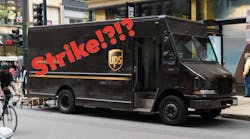UPDATE: What can Brown strike do for you, manufacturer?
UPDATE: UPS and the Teamsters have reached a labor deal, potentially avoiding a crippling strike, per CNN. Read more here.
In recent weeks, it appeared as if UPS workers would go on strike. It is now being reported that a strike has been averted. So what would a strike have meant for manufacturers? We asked Bart De Muynck, chief industry officer at project44, who shared his thoughts before the strike was averted. Take a look…
Smart Industry: What is about to happen with the UPS workers?
Bart: If no contract agreement is reached between UPS and the Teamsters by August 1, the resulting strike will cause massive disruptions to supply chains. The deal is currently stalled but still open, meaning both parties are open to come back to the table and negotiate. Although the head of the Teamsters has asked the White House not to intervene if unionized UPS workers end up going on strike, the White House has been very helpful in negotiating fair contracts in the past, including with the recent rail and port strikes.
Smart Industry: What will the fallout be here?
Bart: I expect we’ll see shortages of inputs and higher shipping prices, which will ultimately be passed on to consumers—and longer lead times for deliveries. The strike would not only create large-scale disruptions to UPS’ network, but would also likely cause broader disruptions to the US supply chain network as FedEx and other last-mile carriers attempt to divert their deliveries to alternatives.
Smart Industry: How will this affect manufacturers?
Bart: UPS handles 25 million parcels per day, which equates to 6% of the GDP. To fill the gap while UPS workers strike, many manufacturers will need to diversify their carriers. However, it is unlikely that these alternatives will be able to fully absorb the entirety of UPS' volume. Additionally, because deliveries will likely be slower to arrive, I expect consumers to turn to in-store shopping. We may even see some businesses offering discounts for consumers opting for in-store pick-up, shrinking in-store inventory faster than usual and putting a strain on manufacturers to keep up with in-store demand.
Smart Industry: Are you aware of any manufacturers taking steps in advance to mitigate problems?
Bart: Last month, project44 data already showed that carrier diversification jumped to 6.2 carriers per account, indicating some manufacturers are already preparing for impact. In the last several years, we’ve seen this diversification as a best practice for mitigating the risk of all sorts of black-swan events. We are also seeing businesses enact scenario-planning to determine if and how they may be impacted to proactively come up with a plan to mitigate as much of the fallout as they can.
Smart Industry: What are the solutions if a protracted strike takes place?
Bart: There’s no possible way to come out of a UPS strike completely untouched, especially given the timing with holiday-shopping season ahead. Yet businesses and manufacturers can proactively manage the risks associated with the UPS strike by conducting scenario-planning, establishing alternative carriers for last-mile deliveries and investing in technologies to increase real-time supply chain visibility. Those that take such precautions can respond to disruptions with agility and maintain operational continuity by implementing comprehensive risk-management strategies today. Knowing no other carrier has the capacity to absorb all the fallout of a UPS strike, manufacturers should also be proactively communicating with their client base to set expectations early. Are you manufacturing life-saving medical equipment that needs to be a top priority? Manufacturers and business leaders need to be aligned on what will take precedence under limited capacity and begin communicating these expectations with clientele now.
Smart Industry: Are there any silver linings to situations like this?
Bart: After every strike, shortage and black-swan event, the supply chain becomes more resilient. A strike like this could exemplify the importance of proper scenario-planning and data-usage for businesses looking to take control of their supply chain, even during unprecedented roadblocks. A strike of this magnitude has the power to reset expectations.
Long term, if shipping costs rise as capacity shrinks, we could see a shift in consumers opting to shop or pick up orders in-store, or carriers pushing for locker drop-off boxes that eliminate the need to navigate to 20 different homes versus one central location. Doing so could ultimately drive a more sustainable supply chain by reducing carbon emissions from delivery trucks.



